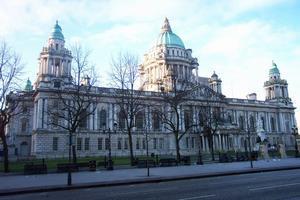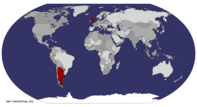Advertisement
Published: July 15th 2006

 Belfast City Hall
Belfast City Hall
During our visit, the trees were green and lovely, but otherwise, this photo does a great job of showing you a little bit of this impressive structure. Many thanks to Nigel Clarke of Lisburn, Northern Ireland, for allowing us to use this photo.After having breakfast at the Europa's generous buffet, we went with Rev. Bill Shaw to see the facilities of the
174 Trust. The 174 Trust was established in 1982 by a group of concerned Christians interested in tackling some of the many problems confronting the local community (unemployment, low education, and crime among them). As though the neighborhood problems were not challenge enough, they selected a physical location in an area that might reasonably be called ground zero for the historic "troubles" in Northern Ireland. A demographic map shows that the 174 offices sit right in the middle of a neighborhood where there are Catholics on one side and Protestants on the other. It's difficult for people like us who don't live in Ireland to comprehend how deep the schism has been, and how long it has been going on - literally for centuries. On the one side are the Nationalists (also sometimes known as Republicans - think Irish Republican Army) who are most likely to be Catholic; they are dedicated to the end of UK rule in Northern Ireland and to a united, independent Ireland. On the other side are the Unionists (also called Loyalists), who tend to be Protestants descended

 Big Fish
Big Fish
When you notice the light pole in the background, it gives you an idea of just how big this fish really is! Thanks to John Self of Belfast for allowing us to post his photo here.from people who came from England, Scotland, and other UK countries, and who tend to favor keeping Northern Ireland in the UK.
I freely admit that my knowledge of "the troubles" was (and still is) very limited, and as an American, I'll probably never fully understand. But I wanted to learn more, and since Bill has lived and worked in the middle of the conflict, I figured he would be a good person to ask some questions. The first thing I wanted to know was what the words "Sinn Fein" mean in Gaelic. Bill replied "only us," referring to the Nationalists' desire to rid Ireland of the "foreign" influence of people from the UK. On the face of it, that might sound reasonably
simple, even if not particularly fair or sensible - make arrangements for people not born in Ireland to go back to their native countries. (Sounds like one of the ideas that people in America had for dealing with the former slaves in the mid-19th century - send them all to Liberia. Some thought it was a great idea; others did not. It never gained great traction in spite of being supported by some American churches. Sadly,

 The Big Fish at the River Lagan in Belfast
The Big Fish at the River Lagan in Belfast
This larger-than-life fish is covered with porcelain tiles, each of which features a bit of Northern Ireland's history - news articles, photos, maps, and even some drawings by children. Many thanks to Matthew Hains of Belfast for allowing us to post his photo here.the result was years of civil war in Liberia between the American immigrants and the natives.) But the problem is that Ireland and the UK have been intertwined for who knows how many years - probably thousands, due to their close proximity. Bill used his own family as an example - they consider themselves Irish, their ancestors having come to Ireland from Scotland
400 years ago. But to Sinn Fein, someone like Bill would be considered an outsider, one who should "go home" to the UK. As Americans, Tim and I had a hard time grasping that - if you're
born in the US, you're an American. It doesn't matter where your family came from or how long ago. And any family with more than one generation of American roots is considered truly American by all but the snootiest of Mayflower families and the scariest of white nationalists or separatists. Even the Native Americans I know (including my relatives) don't tend to be as limited in their view of who is really an American as many Irish Nationalists appear to be in their views of who is really Irish. So the problem runs very deep, and the 174 Trust works

 Thanksgiving Beacon
Thanksgiving Beacon
There's a sign nearby with information about the artist; it says he was inspired by his visit to Thanks-Giving Square in Dallas. Again, thanks to John Self for permission to use his photos.with all sorts of community groups to help bridge the divide and to foster a lasting peace.
After our very interesting and enlightening visit at the 174 Trust, Tim and I ventured off on our own to see the sights of Belfast, including City Hall. This place is so impressive - it looks more like the capital of a wealthy European
country than "just" a City Hall. The inside is truly palatial, and the gardens around the building feature statues of many historical figures. Check out
Wikipedia for some nice photos and also history of the building. Also, the Belfast City Council website has a
virtual tour of City Hall with some great photos. We took a free tour, which ended with a special exhibit about the building's Centennial. Among the interesting points mentioned by our tour guide - Sinn Fein holds 14 (or is it 15?) of the Council's 51 seats. Sinn Fein appears to have evolved into a serious political force even though they don't have a majority at either the City level or the National level. Although politicians may not be our favorite class of people, we much prefer them to any class of people who use

 Thanksgiving Beacon
Thanksgiving Beacon
We thought this was a truly striking piece of sculpture, but we're told that the locals are less impressed and are known to call it "the thing with the ring." Since I was in between disposable cameras and didn't get to take any photos of my own in Belfast, I'm very grateful to John Self of Belfast for allowing us to post photos from his Flickr gallery here.violence to make their point. And at least to people like us on the outside, Sinn Fein has long appeared to be merely a front for the (Provisional) Irish Republican Army.
It's good to hear that Sinn Fein advocates a peaceful solution to "the troubles" - now if they could just learn to back up their advocacy positions with action. The Northern Ireland Assembly was established in 1998 as a result of the Good Friday Peace Agreement (thank you, President Clinton) but it has been suspended since October 2002 because of major disagreements between the Unionist parties and Sinn Fein. Please understand - I don't know enough about this issue to be pointing fingers - maybe the Unionist groups are as much or more at fault than Sinn Fein. Regardless of who's to blame, it's a sad fact that progress toward a true and lasting peace is painfully slow, which assures that Bill Shaw and his colleagues at the 174 Trust will have work to do for many years to come.
One more side note about the 174 Trust - Among their many good works, they operate a day care center for the neighborhood, and they deliberately work to keep a diverse mix of children. They believe that if children play together, away from the prejudices of their parents or false boundaries of their neighborhoods, they will have a better chance of becoming bridge-builders. The program is so popular that there's a waiting list, so that gives us hope for change. In so many ways, the conflict in Northern Ireland reminds me of our own racial problems here in the U.S. Tim and I work to be among the bridge-builders in our community - we live in a racially diverse neighborhood and do our part to support traditionally 'black" events, such as the local Martin Luther King Jr. Day celebration and the annual Juneteenth parade. The fact that ours are two of a very small number of white faces in those crowds shows that America is not always a good role model for peace and reconciliation among its citizens.
And now back to our vacation...
Saturday evening, Bill and his lovely wife Heather picked us up and took us to one of their favorite restaurants near the River Lagan - McHugh's Bar & Restaurant. We had noticed the building earlier in our sightseeing, as it has a sign reading "Established 1711" that caught our attention. We later learned that it's famous for being the oldest building in Belfast. (That seems surprising to us, considering the ancient history of so many other towns in Ireland. Could it be that the ancient buildings were destroyed over the centuries of conflict between Loyalists and Nationalists? I'm sure some would say that Cromwell is to blame for much of the destruction. Or is progress the real villain - old buildings torn down to make way for shiny new structures?) Check out the
Wikipedia article on this place for more info and a photo, or if you're planning a trip to Belfast, check out
McHugh's own website for a calendar of upcoming events. After a delicious dinner and some more interesting conversation, the four of us took a very pleasant stroll in the neighborhood. We stopped to see two fairly new attractions - the Belfast Big Fish and the Thanksgiving Beacon (photos of both above). We crossed the river, walked a little further down the waterfront and came back along a different footbridge.
One interesting bit of information that we learned from Bill and Heather - The Europa Hotel where we stayed in Belfast was long known as the most bombed hotel in Northern Ireland. The Europa was bombed 27 times during "the troubles," which ranks it among the most bombed hotels in all of Europe. With peace becoming a little more secure with every passing year, the owners of this modern hotel have stepped out in confidence with a multi-million dollar renovation, so you would never know that the hotel had ever been damaged. We returned to the hotel with a new respect for the history of the place.
Altogether, this was a wonderful day and an especially lovely evening - thanks so much to Bill and Heather!
You can find lots more photos at the
Wikipedia article on Belfast, including sights we saw, such as the Albert Clock, the Lagan Weir, and murals representing opposing sides of "the troubles."
And thanks to the folks who allowed us to use their photos here. More of Matthew Hains' photos can be seen at
his online gallery. More of Nigel Clarke's photos can be seen at
his online gallery. And more of John Self's photos can be seen at
his gallery at Flickr.com. The really nice thing about Flickr is that it allows you to create sub-galleries of your photos, so you can click on "Belfast" to see John Self's photos of that city, or click on any other of his galleries that look interesting to you.
Advertisement
Tot: 0.119s; Tpl: 0.014s; cc: 6; qc: 44; dbt: 0.0639s; 1; m:domysql w:travelblog (10.17.0.13); sld: 1;
; mem: 1.1mb








